The Vehicles of Iceland
I would be remiss if I didn’t discuss the extraordinary vehicles we encountered during our Iceland trip. But rather than include them in my previous (already-long) post, I’ll do a separate write-up…
ICELAND’S 4X4 WORLD
Iceland’s population of 350,000 is very concentrated. One-third lives in Reykjavik, and the remainder live almost exclusively along the coastal hills, valleys, and plains. The interior of Iceland, often called “the highlands”, is almost entirely empty of people.
Once upon a time, farmers and explorers would pretty much bulldoze out a track anywhere they pleased; this is severely restricted today, and new roads in the back country are few and far between. But many of the old roads remain, and are fertile ground for modern-day exploration.
Consequently, there’s an active market and enthusiastic user base for off-roading. The majority of opportunities exist in the back country’s lava fields, mountains, and ravines — plus the added chance in the wintertime for travel on snow and ice (glaciers).
This scenario creates a “playing field” (literally) for unique types of 4X4 vehicles.
- Basic four-wheel-drive, absolutely required for low-traction environments
- Flotation type footprints for snow, mud, and minimal trail damage
- Huge ground clearance to survive deep river crossings
- Large passenger capacity for paying tourists
The most interesting, and unique, aspect of Iceland’s 4X4’s was that the need for huge flotation tires — 44-48″ was common to see — way overwhelmed any need for big suspension travel. Those big tires just weren’t going to move up and down as far as smaller ones would, but that’s OK. The primary requirement is flotation and ground clearance. Boulder-crawling and such are much lesser needs. So what we saw was HUGE tires, pretty much nestled in slightly more huge wheel wells. In fact, there must be a big custom-fender business in Iceland, because the giant flares on custom rigs were very well fabricated and finished, not at all an amateur effort in any way.
Being an avid off-roader myself, my eye was frequently caught by passing cars and trucks which had been adapted — or out-and-out created — for roaming the Icelandic highlands. Many were obviously for commercial purposes, and therefore justifying the large expense of acquisition and upgrades. Others were pretty clearly private vehicles, hobbies at the owners’ sole discretion. Here are some examples…
In the US, a stock Mercedes 4X4 can run into the $100,000 range. I wonder what these tip the scales at in Iceland, where vehicles can be 2X the cost? They appeared to be privately-owned…
And although there are many multi-passenger rigs around, sometimes even the commercial vehicles are only 4-person.
Lots of really unique rigs were to be found.
The term “4X4”, or “4WD” is commonly used to indicate the driven power is delivered to all axles. But what if you have more than four wheel positions? You get a 6X6.
And of course, Search and Rescue would have the ultimate need for a gnarly 4×4.
This was a new one on me — external self-inflating. I’ve known about internal systems for some time (typically found on military vehicles). But this one has pivoting fittings on the outside, so that the axles don’t have to get fancy. Pretty cool, except that it sure seemed vulnerable to getting snagged by brush — or even by passing rear-view mirrors. Personally, I’d route the air lines closer in.
And then, the motorcycles. Besides the substantial numbers of local riders, there are also the remote-country adventure types. No flotation tires or all-wheel-drive, just knobbies, big luggage boxes, and lots of hutzpah on the part of the riders. There’s a lot of rain in Iceland — it ain’t this sunny or dry all the time.
As motorhome owners, we always notice the big rolling boxes. These, not for off-road, although they could both <maybe> handle F35. But the big one is too long and too wide for many of Iceland’s roads. I wonder how they use it?
This may have been the ultimate “off road weapon”, but since it wasn’t highway legal, I include it here just for contrast. This tractor hauled 20 of us in the hay cart, across miles of tidal flats, to go see the eastern Puffin colony. Slow, but sure, trekking across deep, slushy ruts in the ever-shifting sands.
And let’s not leave out the “poor man’s off-road vehicle”. A surprising number of cyclists were venturing across the rugged highlands. I wonder how they dealt with the river crossings… hitch a piggyback ride?
ROADS and RESTRICTIONS
You hear different stories, and see various signage, about what is and isn’t “allowed” on Iceland’s back roads. Firstly, it’s absolutely forbidden (and poor practice anyway) to travel on private land, or across raw land of any kind. No new tracks are allowed, period. Arrests have been made, and heavy fines.
But as to driving on an established road, the “rules” are largely economic. Rental car companies will not cover any support costs for non-4×4 vehicles on ‘F’ roads, for example. No insurance is available for coverage for ANY vehicle in a river crossing. You drown it, you own it. And at Iceland’s sky-high pricing, the bill for a ruined car can top $50,000.
We saw many signs like this one, “prohibiting” non-4X4 vehicles on F roads.
In fact, the F roads are, in many cases, in much better condition than a huge selection of plain-old dirt roads that we drove on in the coastal sections. The Westfjords, for instance, have tiny 1-lane roads with severely rocky sections, where in fact we received our one-and-only rock-chip flat on the trip. And these lesser roads have no such signage or restrictions. (However, I would not want to test the rental company’s customer-satisfaction policy by breaking down at the tip of a dirt-road-accessed peninsula.)
We also saw MANY non-4×4 cars out in the remote areas (where they are “prohibited” according to the signage). And we NEVER saw any police or enforcement vehicles away from the cities. So clearly, it’s pretty much a self-regulating scenario, governed by the laws of nature — and unskilled drivers, of course.
After a lot of research, we elected to self-drive on F35, and verbally ‘cleared’ our plan with the rental company. Our other choice, F26, was deemed a bit risky due to river crossings.
Yup, later on, we took a super-Jeep tour, and got to see those 2+-foot-deep river crossings from the vantage of a super-high-clearance vehicle. We made the right decision. Our RAV4 would have — at best — loaded up the interior with 50 gallons of icy glacier water. At worst, we’d have drowned the engine, floated into some hole, and run up a $50,000 bill, no insurance.
Something that’s not obvious until you’re “there” is the fairly narrow lane widths. Eight feet is common, nine feet is generous. For a 6′-wide passenger vehicle, that might seem easy, but remember that in the US, we are accustomed to 12′-14′ lanes on our highways. Here’s an 8-foot-wide trailer, rolling (carefully) down a highway with 9′ lanes, at 90kph with crosswinds. Snug.
Our non-adventurous vehicle was a vanilla RAV4, no mods, street tires. Oh well. It was comfortable, and it got us around the country for three weeks with little mishap.
THE “SUPER-JEEPS”
All of the back-country tours, and there are many available, make the use of truly special vehicles. Many are highly modified, and some are full-custom. Interestingly, we never saw an actual Jeep (brand) of any kind modified into the “super Jeep” category, although there were plenty of lifted Jeeps with big tires.
Our own Super-Jeep, in which we traveled to the Askja Crater, was a custom build: F350 pickup front end, and Ford Excursion rear end. The 44″ tires and huge suspension lift provided enough clearance for 30″ deep river crossings. Beautifully done, at a reported cost of about $250,000.
Tires were 44″ diameter, 18-20″ wide. A 475/70R17 is a commonly-used size.
For our southern-Iceland tour of the Mt. Laki area (near Vatnojokull NP), we were transported in another custom, this time a heavily modified Econoline van. This one was so tall that it needed multiple steps to board (pneumatically deployed).
This one was gorgeous; I couldn’t tell whether it was a commercial (tourism) vehicle or a private one for a big family.
Hmmm, I wonder where “Super Jeep” ends, and “Super BUS” begins? Certainly, this is past the threshold.
SUMMARY
As a dyed-in-the-wool off-roader, I was constantly delighted with the quantity and variety of “big rigs” in Iceland. Maybe some day I can go back there and drive one. Or my motorcycle. Sheesh, what a choice to have to make.
OK, both.
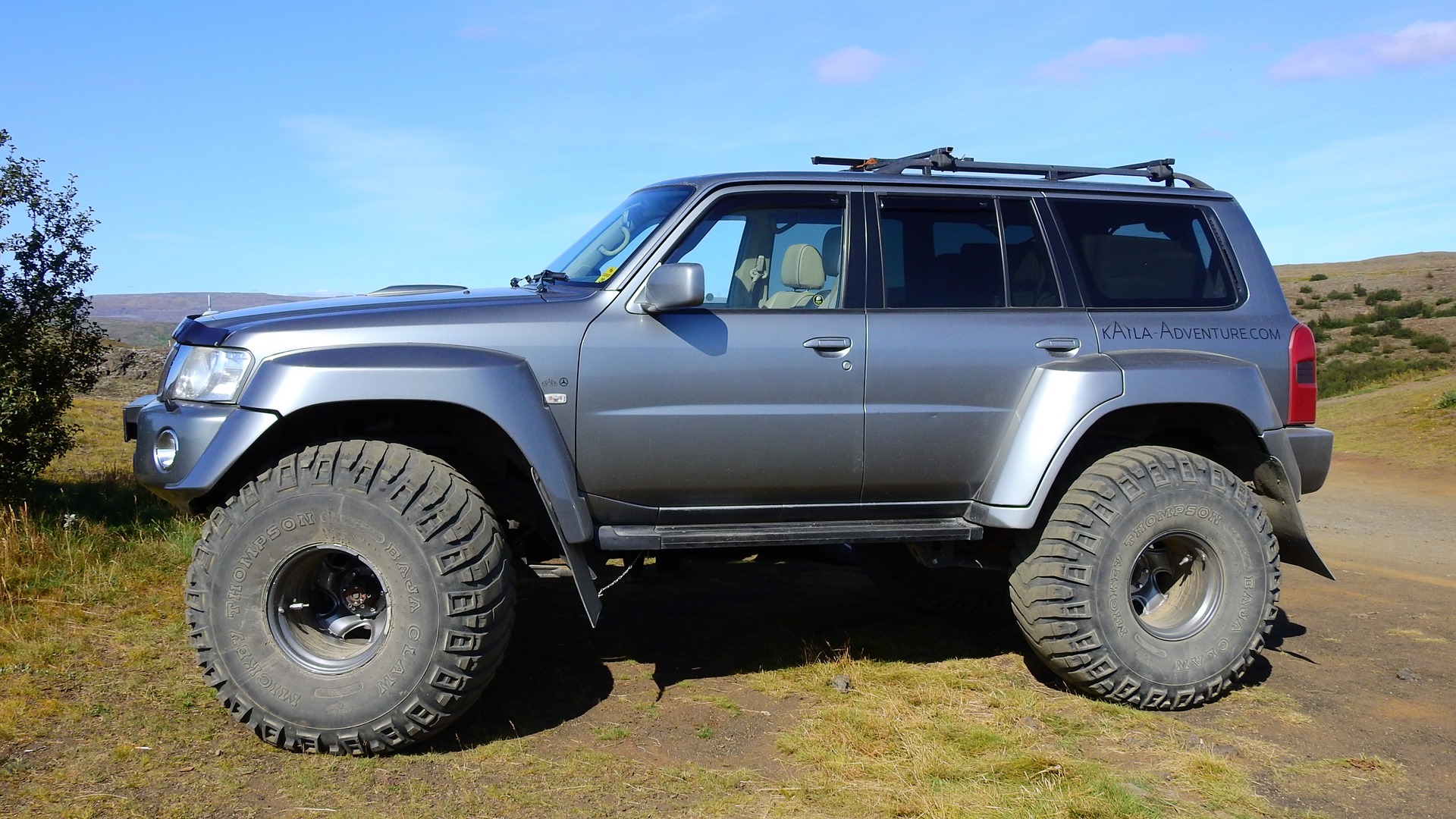
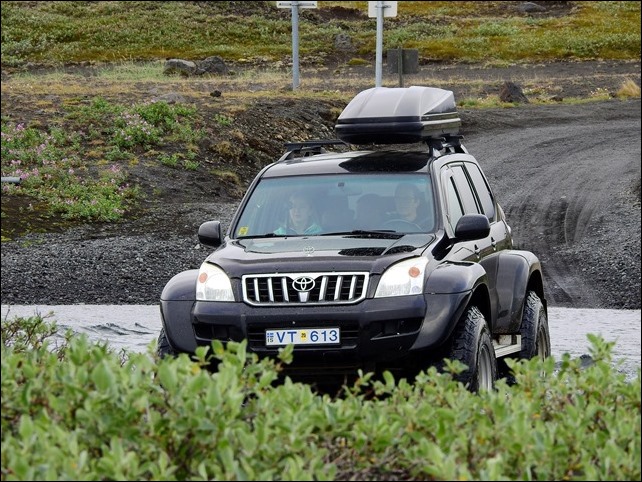
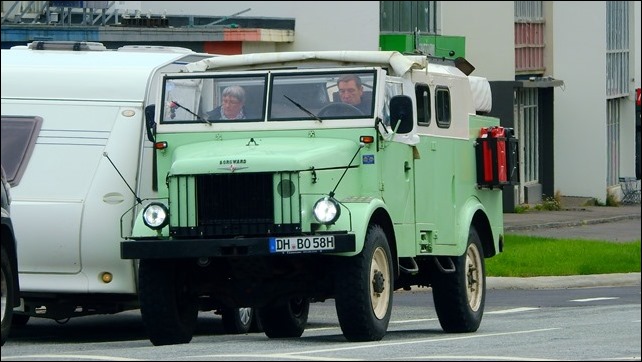
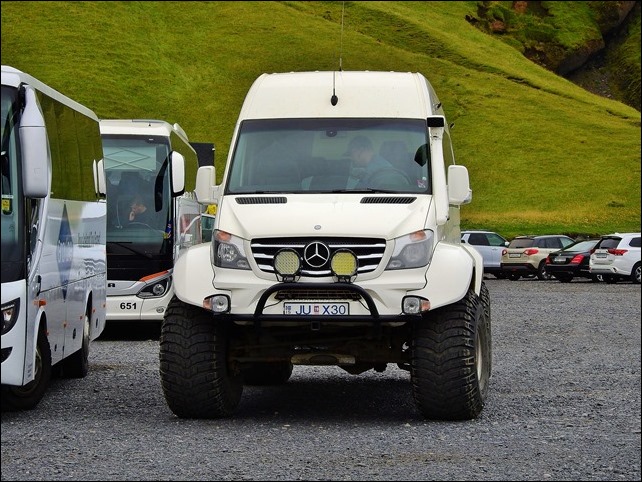
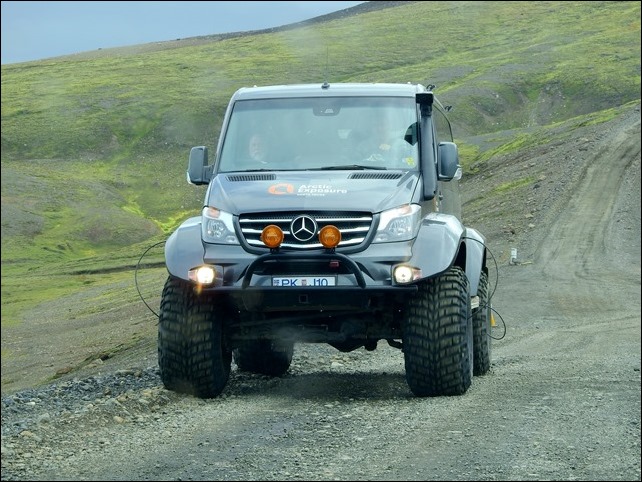
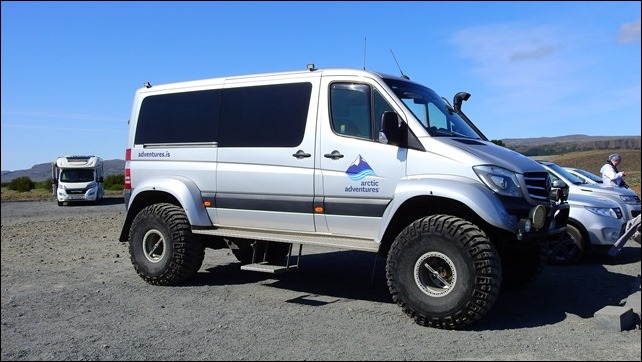
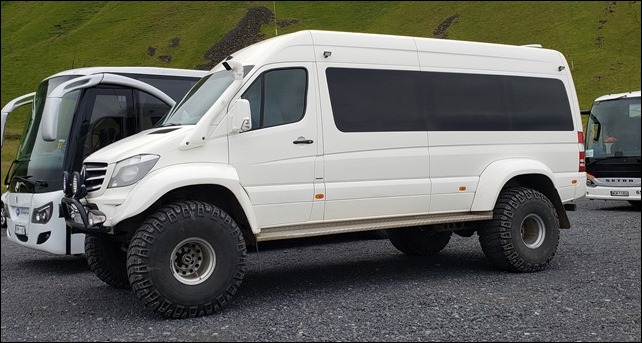
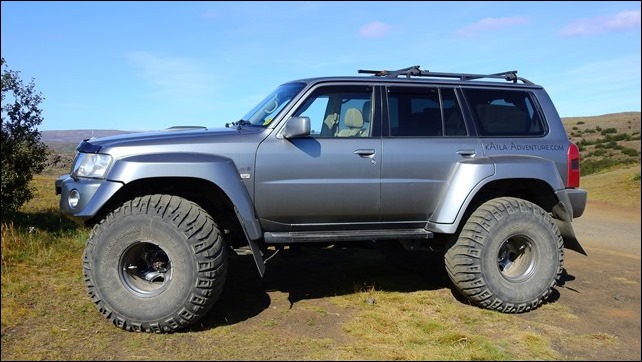
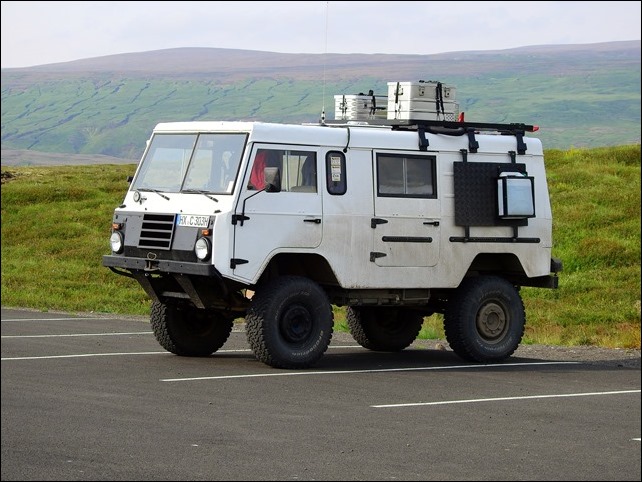
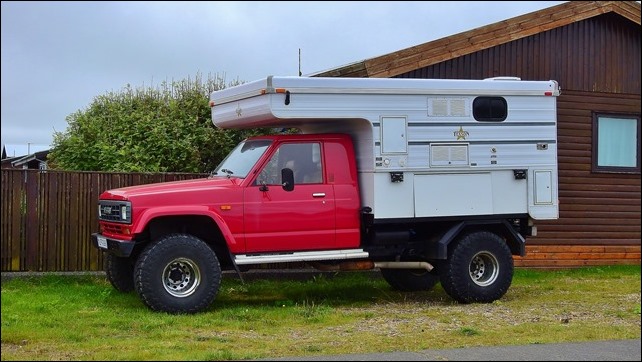
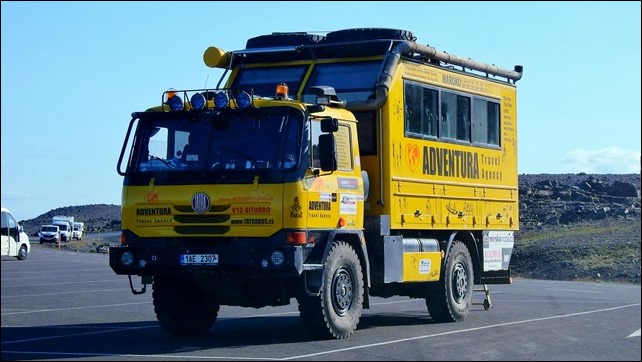
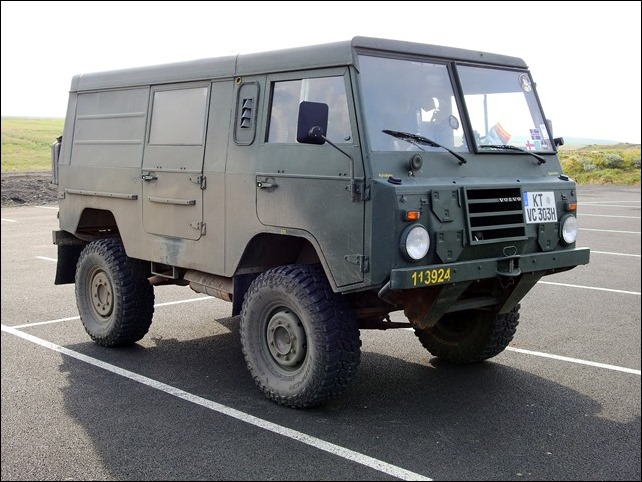
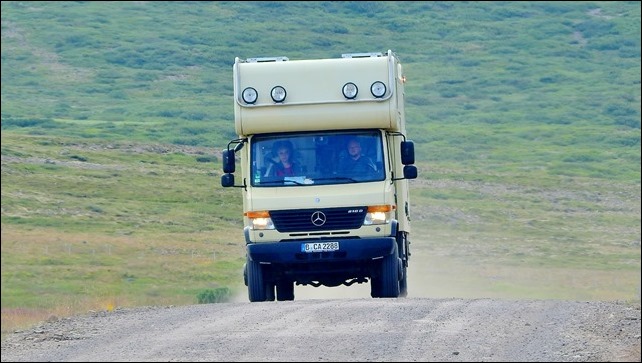
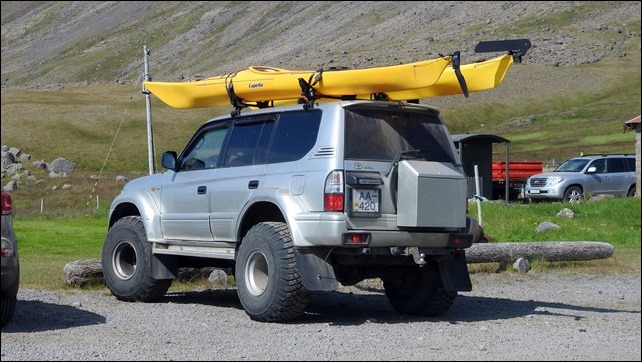
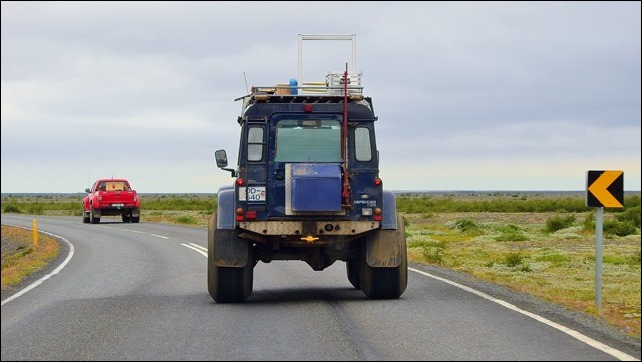
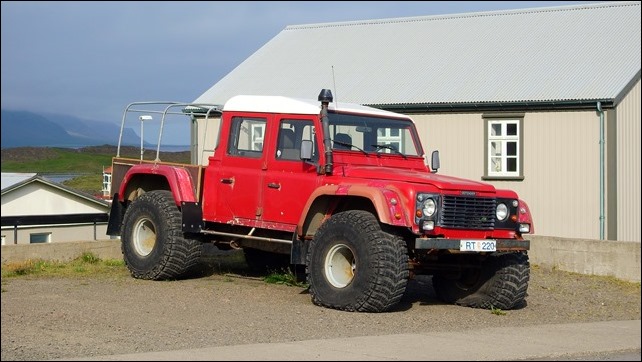
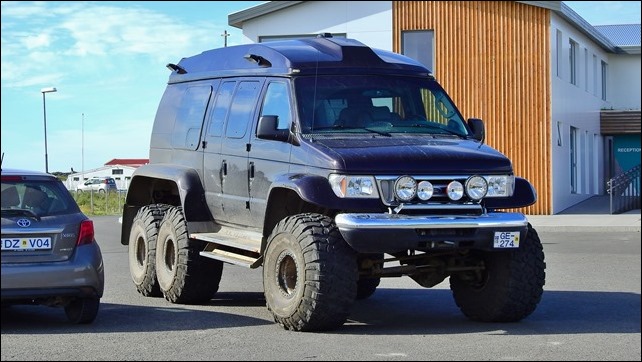
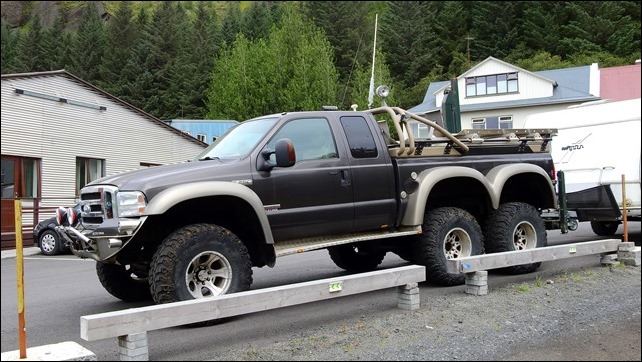
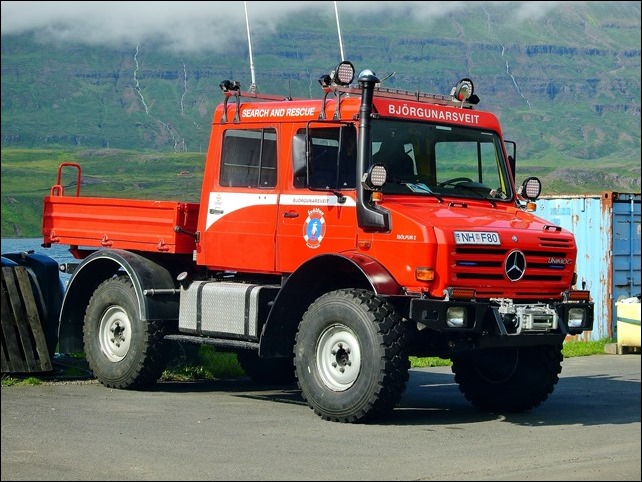
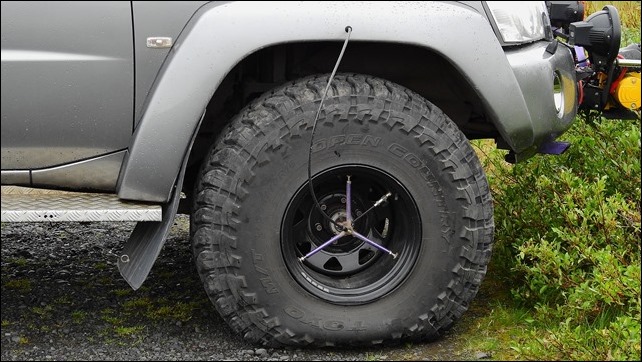
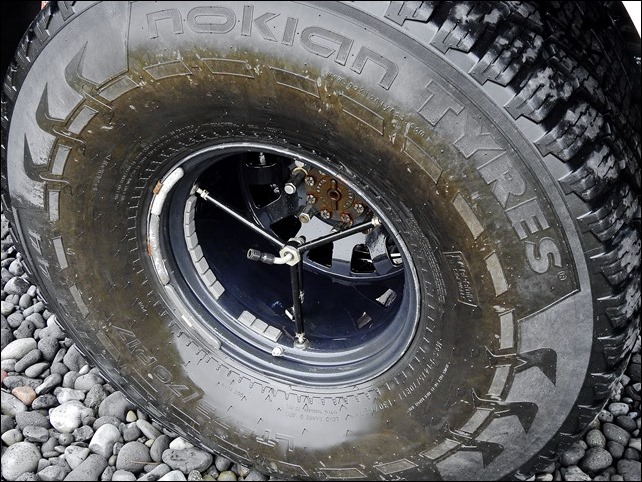
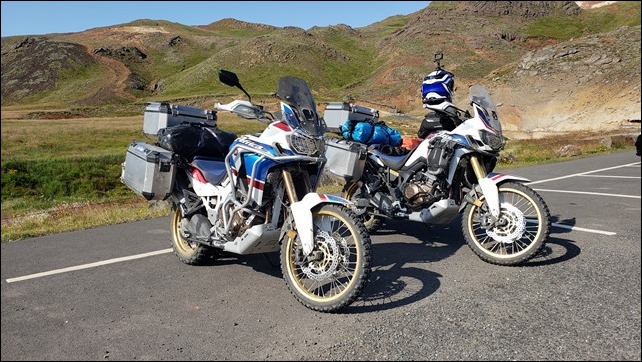
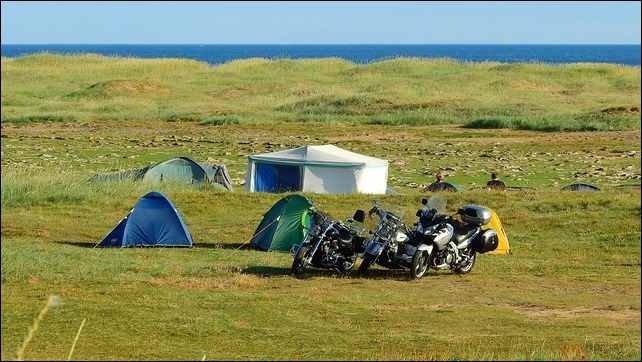
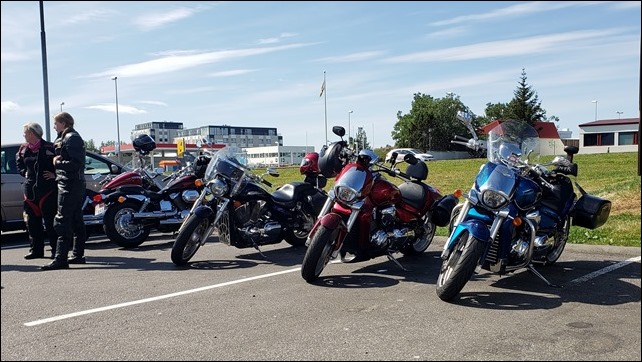
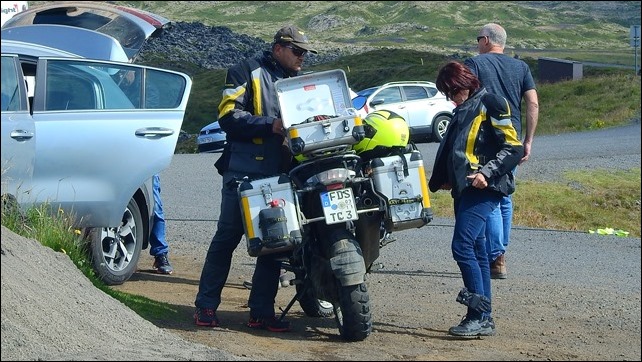
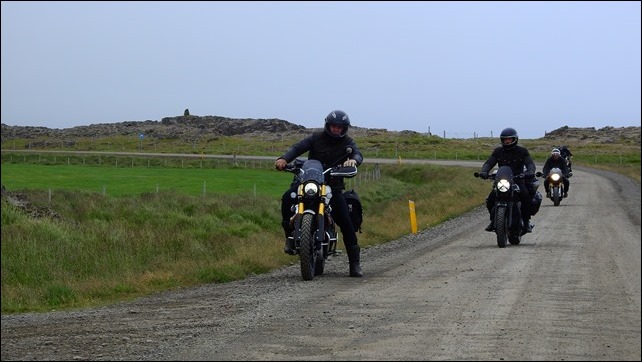
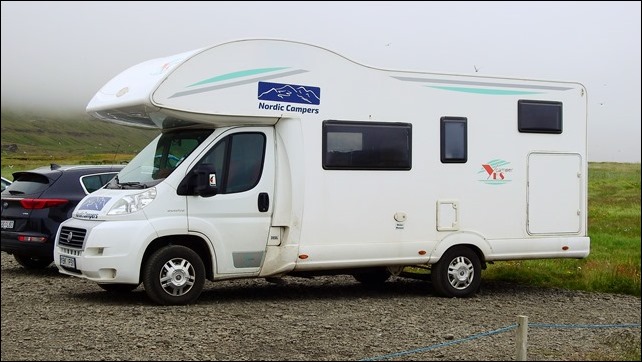
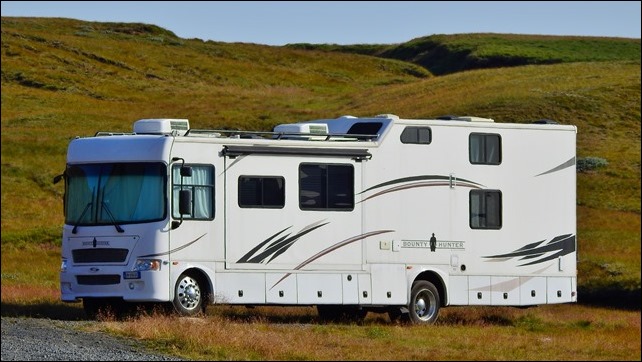
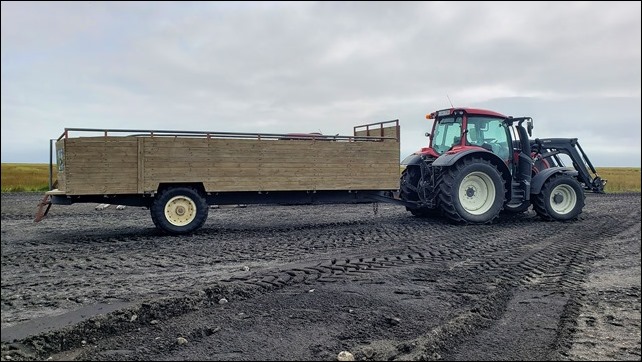
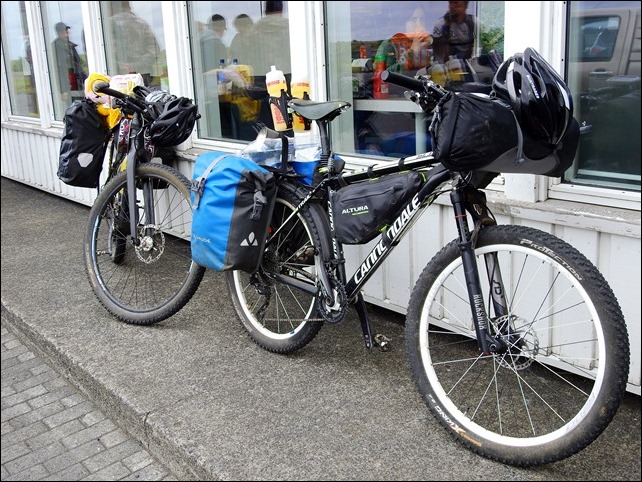
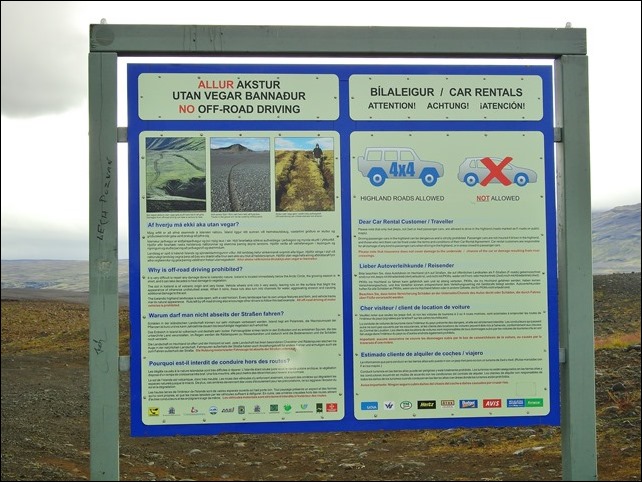
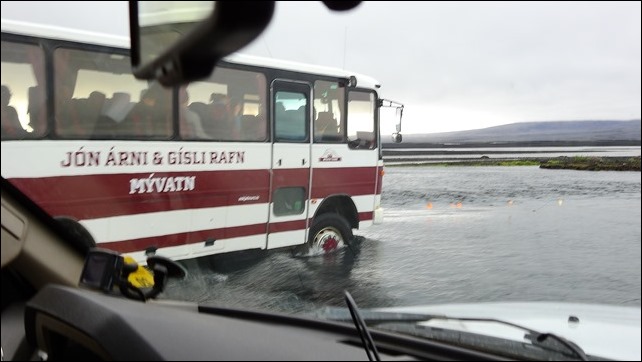
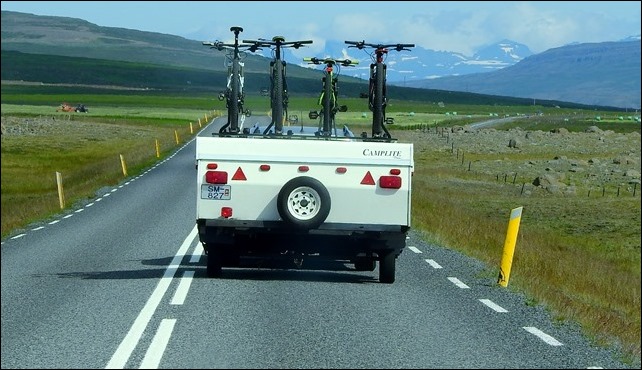
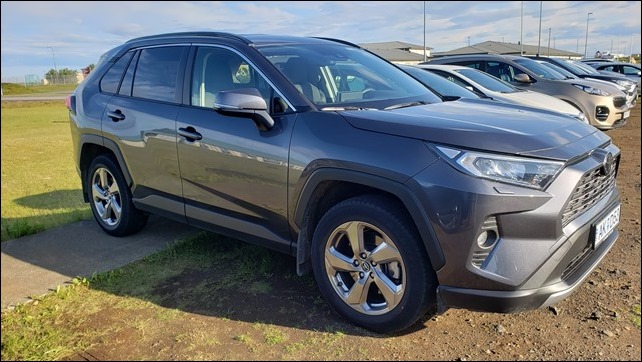
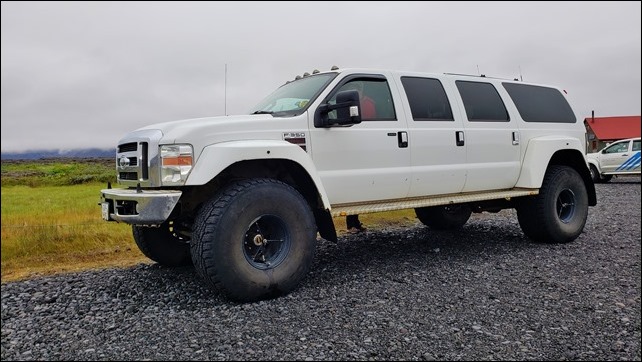
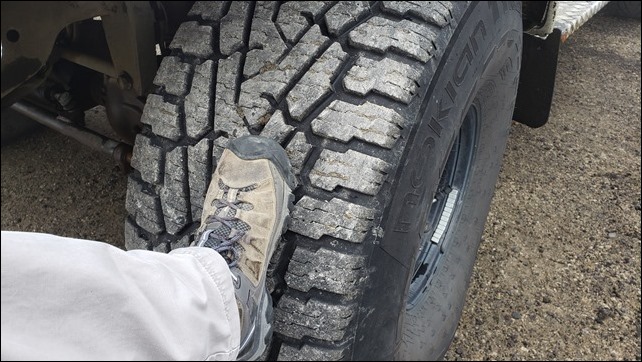
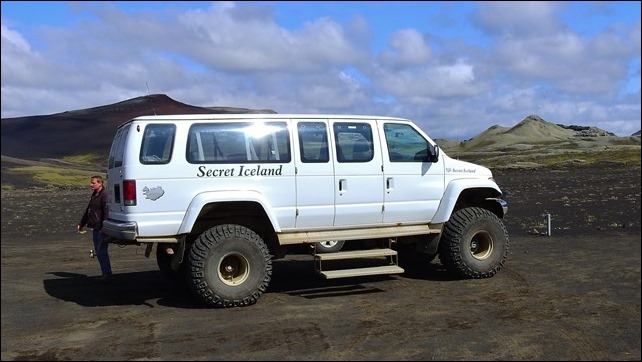
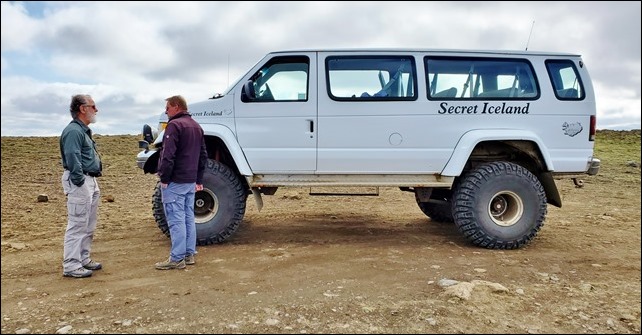
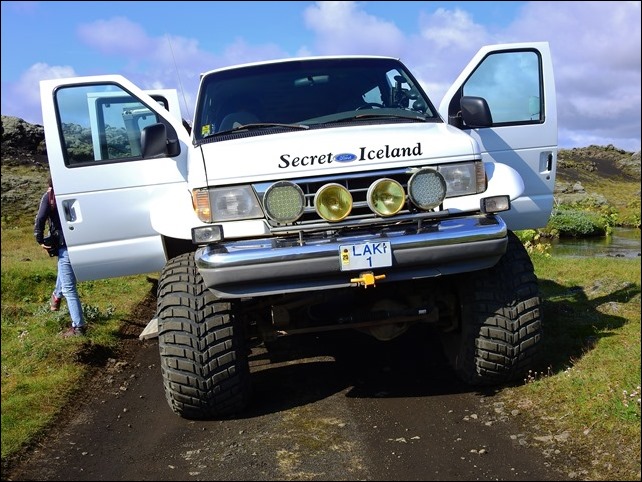
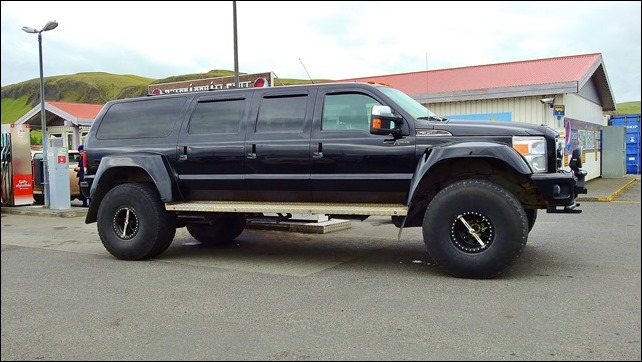
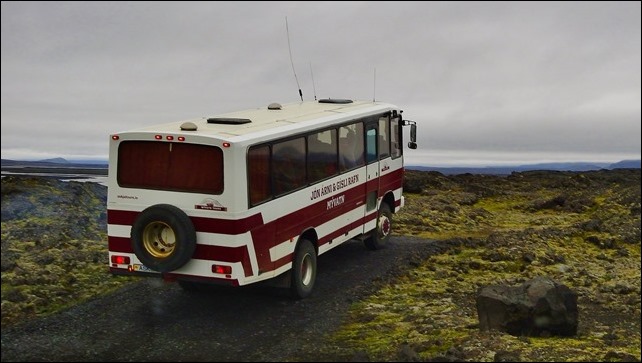
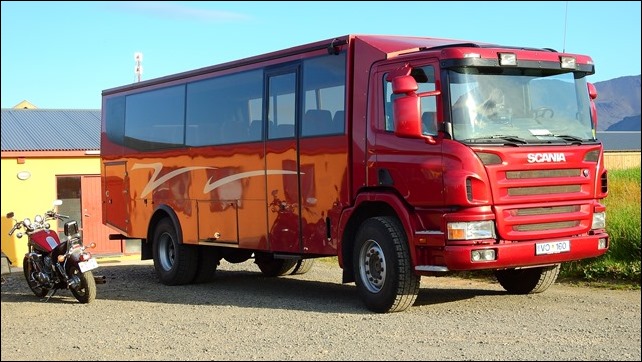
Very interesting as I spent some time in Naval Station Keflavik and flew many hours in really difficult conditions but was very satisfied with the tour of duty. At the time I was there the population was about 250,000 and each person was allowed 4 sheep per capita and all ran free and were branded/marked somehow and when shearing was due they had volcano rock corrals and everybody sheared sheep regardless of who was the owner and then they went around and collected there respective piles. It was a major penalty if one was to hit a sheep with a vehicle. Very interesting country as so much to explain..It was tough duty due to winds & weather as flying was a challenge..Seven NATO countries actually protect Iceland in order to use their base..to my knowledge they do not have a defense budget unless things have changed and the Coffee will knock your socks off..All churches are on real high ground points..
Yes and we also learned that many of the ranchers name ALL of their sheep when they’re over 2 years old, and remember them year after year.
That was awesome Greg. Thanks for sharing a great trip
As you can imagine- we loved this article!